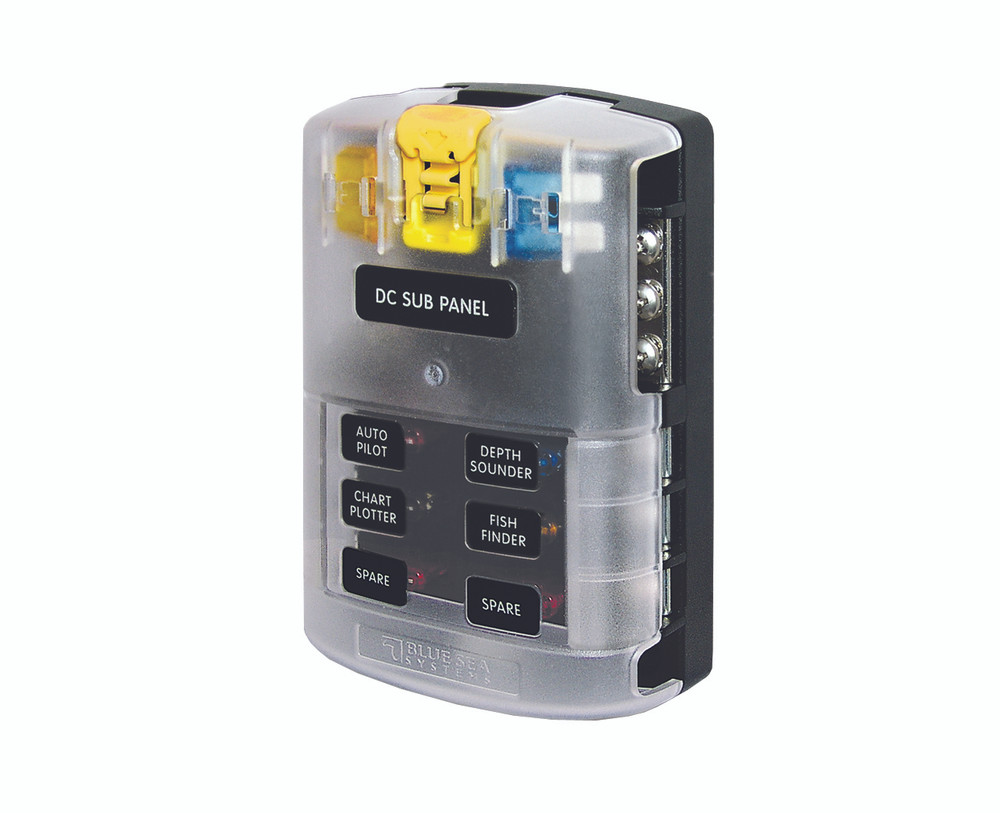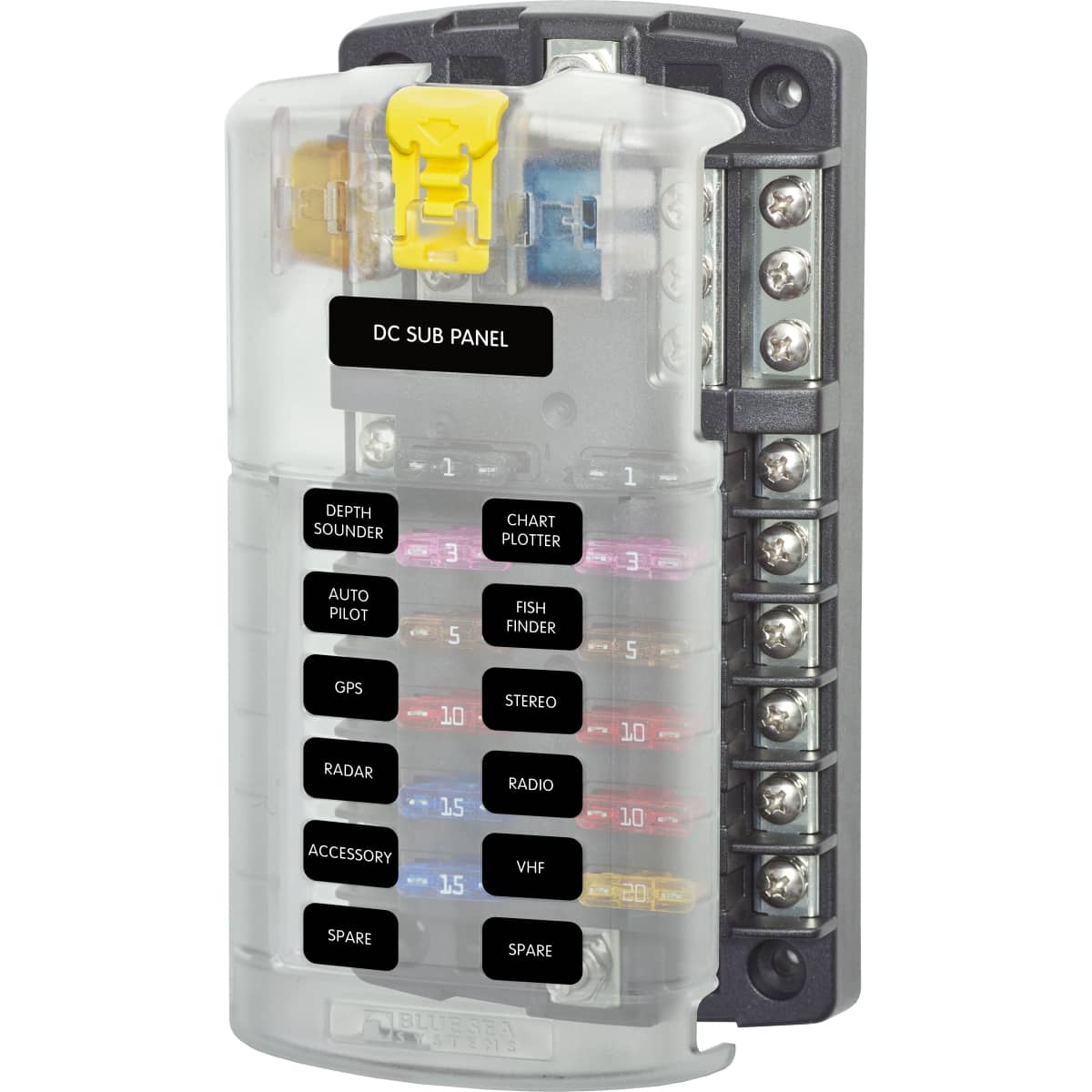Our Blue Sea Fuse Block Ideas
Wiki Article
All About Blue Sea Fuse Block
Table of ContentsOur Blue Sea Fuse Block PDFsThe Main Principles Of Blue Sea Fuse Block 3 Easy Facts About Blue Sea Fuse Block ExplainedThe 7-Second Trick For Blue Sea Fuse BlockBlue Sea Fuse Block for Beginners6 Easy Facts About Blue Sea Fuse Block Described
Fuses are bolted in position in between the bus bar as well as the 2nd set of electrically isolated bolts. With this installation you can affix the boat's different high-current circuits, such as a windlass, bow thruster, high-output generator, the DC panel, etc, to the separated screws. The numerous merges are sized according to the current-carrying capability of the conductors bolted to them.Some circuits will certainly still require to bypass the isolation button to make sure that they may be left on when the remainder of the watercraft is shut down. blue sea fuse block. These circuits normally consist of a bilge pump and also any charging gadgets (including solar panels, possibly a wind generator, and also the inverter if it additionally doubles as a battery charger).
This is component of the circuit diagram we developed for the facility example boat in our Watercraft Electrics course. The tools connected to the fuse block in the upper right are all bypassing the isolation button S1. If you enroll in Watercraft Electrics 101, you will learn exactly how to check out such a representation and likewise how to make one for your very own watercraft.
Not known Facts About Blue Sea Fuse Block

With DC circuits, the OCP is always placed in the positive side of DC circuits. Keep in mind that some European boatbuilders mount fuses as well as battery buttons in the DC negative side and also on the positive side, however this is not recommended other than in some separated (drifting) ground DC systems.
This factor might be at the battery, the battery switch, the circulation panel, a subsidiary panel, some distribution bus bar, or other linking point. If the conductors in the brand-new circuit are no smaller than the conductor that feeds the brand-new circuit's point of link, after that the OCP for the feeder conductor will sufficiently protect the brand-new circuit - blue sea fuse block.
Not known Factual Statements About Blue Sea Fuse Block
If the new circuit is not appropriately served by overcurrent tools currently in area, additional defense is needed at its factor of link, i. e., at its resource of power. Placement of integrates in the favorable conductor. Keep in mind just how a smaller fuse is utilized whenever a smaller conductor is attached, In some cases area limits exactly how close an OCP device can be positioned to the source of power.If they need to be installed in battery areas, they should be ignition shielded.) The concern after that company website arises, just how close is close enough? The generic answer, from the ABYC, is within 7" linked here (17. 5cm). The ABYC permits the complying with, which have been tightened up in the last few years: A conductor linked directly to a battery that is additionally "contained throughout its entire range in a sheath or room such as an avenue, joint box, control box or encased panel" need to have its overcurrent protection "as close as possible to the battery, but not to surpass 72 inches (1 - blue sea fuse block.
Gone is the covering 72" allowance that made use of to be there. A conductor linked to a resource of power besides the battery (e. g., the battery button, the circulation panel, or a few other point in the DC circuits) that is likewise consisted of in a sheath, and so on, must have its overcurrent protection "as close as achievable to the point of connection to the resource of power, but not to surpass 40 inches (1.
Little Known Questions About Blue Sea Fuse Block.
e., any place it links right into the DC system. Given that alternators themselves give power, it has been arguable whether these included alternators called for OCP at the generator itself. This has been dealt with in the most current variation of the ABYC E-11 requirement as follows: "Overcurrent security is not required at a generator if the ampacity of the conductor amounts to or more than the ranked result of the alternator."Cranking-motor circuits are not required to have overcurrent protection.In the marine field, where cranking circuits might be long, this method might develop a risk. If a cars and truck catches fire, the residents can draw over and also jump out. If a boat ignites, it is not so easy. It makes no feeling to have any type of vulnerable circuits on a watercraft.
In winter, the inrush present on a 12V starter electric motor might be as high as 1,500 amps; the cranking current may be as high as 200 amps. Often, cranking conductors are undersized also for the cranking current, not to mention the inrush current. This circumstance does not present a safety problem per se, since these currents are endured for just a few secs, so the conductors do not have time to get hot enough to create a fire threat.
Blue Sea Fuse Block Fundamentals Explained
If you wish to find out exactly how to wire a boat, step-by-step my sources in 56 video lessons, inspect out our Watercraft Electrics 101 program. We made the program with absolute novices in mind. As the electrical tons on boats increases, so as well does the complexity of electrical circuits and the possibility for short circuits and also electrical fires.
In the aquatic area, where cranking circuits may be long, this method could produce a hazard. It makes no sense to have any type of vulnerable circuits on a watercraft.
Some Of Blue Sea Fuse Block

If you wish to find out how to wire a watercraft, step-by-step in 56 video lessons, check out our Watercraft Electrics 101 training course. We made the program with absolute newbies in mind. As the electrical load on boats boosts, so also does the intricacy of electric circuits as well as the possibility for short circuits and electric fires.
Report this wiki page